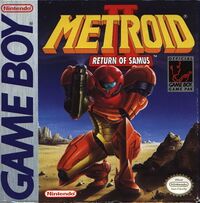Navigation menu
Metroid II: Return of Samus: Difference between revisions
Metroidking (talk | contribs) m (fixing the developer) |
(rating info) |
||
| Line 7: | Line 7: | ||
|released=(NA) August 26, 1991<br>(EU) May 21, 1992<br>(JP) January 2, 1992 | |released=(NA) August 26, 1991<br>(EU) May 21, 1992<br>(JP) January 2, 1992 | ||
|genre=Action Adventure | |genre=Action Adventure | ||
|ratings=ESRB: | |ratings=ESRB: K-A (Player's Choice release) | ||
|modes=Single-player | |modes=Single-player | ||
|media=2-megabit cartridge | |media=2-megabit cartridge | ||
Revision as of 03:19, 4 July 2010
This article is a stub. You can help Metroid Wiki by expanding it.
Metroid Wiki is in need of filling in various stubs!
| ||||||||||||||||
| ||||||||||||||||
Metroid II: Return of Samus is the second game of the Metroid franchise, and is the original sequel to the 1986 NES title Metroid. It was released for the Game Boy in 1991.
Story continuity
Although Return of Samus was originally intended as a sequel to Metroid, several newer games take place between the two titles. The entire Metroid Prime trilogy takes place between Metroid and Return of Samus, placing the game sixth in the timeline.
After Samus' mission on SR388 is over, she brings the last surviving Metroid to the Ceres Space Colony to have scientists harness its power. After it is stolen by Ridley, Samus returns to Zebes to find it. This story is told in the 1994 SNES title Super Metroid.
Gallery
-
Samus, as she appears in the official artwork
-
Title Screen
-
Samus leaves her gunship
External Links
A Complete Map of Metroid II's SR388

